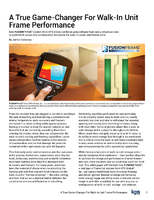Toolholding System has design that reduces runout.
Press Release Summary:
Head Fitting System (HFS) toolholder design increases tool life by up to 3X. Face contact added to taper connection provides longitudinal positioning accuracy equal to one-piece tools and concentricity and changeover accuracy is less than 3 microns. Design consists of head, holder, and differential screw. Tool can be changed without presetting or adjustments, and defined release force enables removal after long-term use. All functions are activated with one screw.
Original Press Release:
New Toolholding System Increases Tool Life Up to 3X By Reducing Runout
(Piscataway, NJ; September 30, 2003) -- Mapal has announced the introduction of its Head Fitting System (HFS) toolholder line, which increases tool life up to 3X through a new design that reduces runout. Traditional toolholders for rotary tooling use a taper without face contact, resulting in concentricity inaccuracies that put most of the chipload on a few teeth with a negative impact on tool life. Mapal's new HFS design adds face contact to a taper connection to provide longitudinal positioning accuracy equal to one-piece tools. As an example of the improvements that can be achieved with the new toolholding system, MTU Aero Engines, Germany's leading aerospace engine manufacturer and also a major driveshaft supplier, increased tool life in a reaming operation from 2000 to 6000 pieces per tool simply by switching to HFS.
Up to now, companies engaged in high-production rotary tooling applications such as face milling, end milling, drilling, reaming and boring, have had to choose between two flawed toolholding alternatives. One-piece tools provide longitudinal accuracy, which increases tool life, but are more expensive because the shank is discarded along with the tool. This approach also makes it necessary to measure and adjust the tool on the machine each time it is changed, reducing uptime. Traditional toolholders, on the other hand, reduce overall tooling costs and allow tool setup to be performed off the machine. But the taper-contact used to maintain position of the tool provides excessive runout, concentrating the chipload on a just a few teeth and reducing tool life.
The use of face contact in the HFS improves both concentricity and changeover accuracy to less than 3 microns. This means that the new tools can provide the accuracy of one-piece tools along with the low-cost and higher uptime of traditional toolholding systems. These benefits are achieved with a unique design consisting of only three parts, head, holder and differential screw. The screw draws the taper in to make face contact or ejects it, depending on the direction of rotation. The tool can be changed without presetting or adjustments. A defined release force makes it easy to remove even after long-term use. The fact that all functions are activated with a single screw makes the HFS very easy to use.
An example of the tool life improvements that can be achieved with the new toolholding system is provided by the MTU application. The company reams drive shafts for automobiles with rapid-set heads using Cermet blades. Using conventional toolholders, tool life was about 2,000 pieces between regrinds. To make sure that tools could actually be removed after the operation, tapers of the toolholders used in the past were greased. Concentricity errors of up to 20 microns were the factor that limited tool life. The first trials with the HFS showed an immediate improvement in tool life to 6,000 parts. The result was that MTU changed its machines over completely to the new toolholding system.
For further information, Contact Susan Ephraim at Mapal -- Ph: 732-572-6700, Fax 732-572-7717 sephraim@mapalus.com




